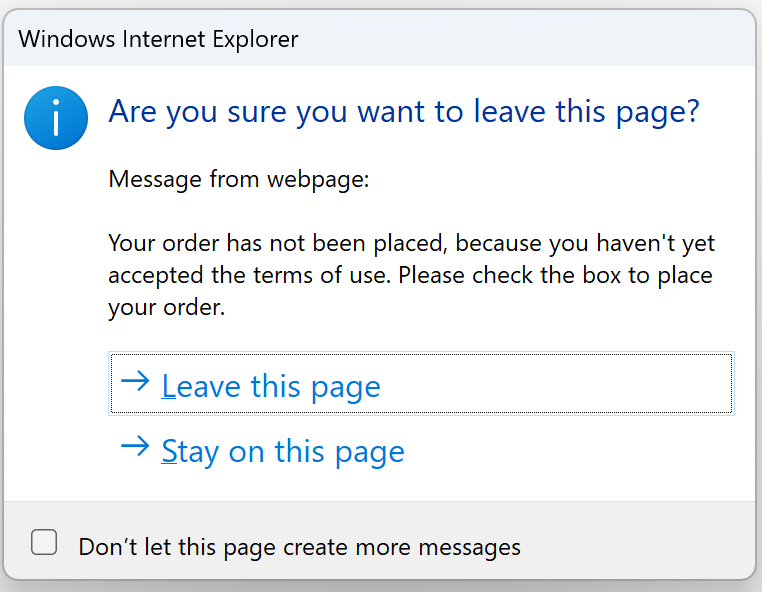When moving from other development platforms to the web, developers often have a hard time understanding why the web platform seems so … clunky. In part, that’s because the platform is pretty old at this point (>25 years as an app platform), partly because changes in form factors and paradigms (particular mobile) have introduced new constraints, and partly because the Web is just lousy with bad actors hoping to do bad things.
One “simple thing” desktop developers expect to be able to do is to prompt the user to take some action before leaving an application (e.g. “Save your work?”). For years, browsers offered a simple mechanism for doing so: closing the browser, navigating to a different page, or hitting Refresh button would trigger an OnBeforeUnload() event handler. If the developer’s implementation of that function returned a string, that string would be shown to the user:
Unfortunately, tech scam sites would often abuse this and use it as yet another opportunity to threaten the user, so browsers decided that the most expedient solution was to simply remove the site’s control over the prompt string and show a generic “Changes might not be saved” string, hoping that this reflected the webapp’s true concern:
For the dialog to even display, there must have been an earlier user-gesture on the page; if there was no gesture, the dialog is suppressed entirely.
For some applications, this prompt works just fine, but for complicated workflow applications, the user’s issue might have nothing to do with “saving” anything at all. A user who wants to satisfy the app’s concern must click “Stay on page” and then scroll around to try to figure out where the problem is.
You might hope that you could just update your page’s DOM to show a alert message beside the built in prompt (“Hey, before you go, can you go verify that the setting <X> is what you wanted”, but alas, that doesn’t work — DOM updates are suppressed until after the dialog is dismissed.
Browsers won’t even emit the site’s string into the DevTools console so that an advanced user could figure out what a site was complaining about without manually stepping through the code in a debugger.
Web Platform evangelists tend to reply with workarounds, trying to guide developers to thinking in a more “webby” way (“Oh, just store all the data in indexedDb and restore the state the next time the user visits“), and while well-intentioned, this advice is often hard to follow for one reason or another. So users suffer.
A simple test page.
I’m sad about this state of affairs — I don’t like giving bad guys power over anyone. This truly feels like a case where the web platform threw the baby out with the bathwater, expediently deciding that “We cannot have nice things. No one may speak, because bad people might lie.” The platform could’ve chosen to have a more nuanced policy, e.g. allowing applications to show a string if there was some indication of user trust (e.g. site engagement, installed PWA, etc).
:-(
Impatient optimist. Dad. Author/speaker. Created Fiddler & SlickRun. PM @ Microsoft 2001-2012, and 2018-, working on Office, IE, and Edge. Now a GPM for Microsoft Defender. My words are my own, I do not speak for any other entity. View more posts



